Analysis on the Rationality of Urban Green Space Distribution in Hangzhou City Based on GF-1 Data
Abstract
1. Introduction
2. Materials and Methods
2.1. Study Area
2.2. Data
2.3. Data Pre-Processing
2.4. Method
3. Results
3.1. Extraction of UGS of Shangcheng District
3.2. Extraction of UGS of the Main Urban Area of Hangzhou
3.2.1. Special Distribution of UGS in Hangzhou
3.2.2. Special Distribution of UGS in Each District
4. Discussion
4.1. Accuracy Analysis
4.1.1. Comparison with Statistical Yearbook
4.1.2. Stability Analysis
4.1.3. Comparison of Different Methods
- 1.
- Normalized Difference Vegetation Index (NDVI) model
- 2.
- Pixel Bipartite Model
4.2. Analysis of Temporal Changes of UGS in Shangcheng District
4.3. Analysis of Spatial Distribution of UGS in the Main Urban Area of Hangzhou
4.3.1. Special Distribution of UGS in the Main Urban Area in Hangzhou
4.3.2. Special Distribution of UGS in Each District
4.4. Analysis of Temporal Changes of UGS in Shangcheng District
4.4.1. Policy
4.4.2. Resident Demand
4.4.3. Economic Development
4.5. Strengths, Limitations, and Future Study
5. Conclusions
Author Contributions
Funding
Institutional Review Board Statement
Informed Consent Statement
Data Availability Statement
Acknowledgments
Conflicts of Interest
References
- Kessel, A.; Green, J.; Pinder, R.; Wilkinson, P.; Grundy, C.; Lachowycz, K. Multidisciplinary research in public health: A case study of research on access to green space. Public Health 2008, 123, 32–38. [Google Scholar] [CrossRef]
- Yu, S.; Zhu, X.; He, Q. An Assessment of Urban Park Access Using House-Level Data in Urban China: Through the Lens of Social Equity. Int. J. Environ. Res. Public Health 2020, 17, 2349. [Google Scholar] [CrossRef] [PubMed]
- Tu, X.Y.; Huang, G.L.; Wu, J.G. Review of the relationship between urban greenspace accessibility and human well-being. Acta Ecol. Sin. 2019, 39, 421–431. [Google Scholar]
- Li, B.B. Study on Green Space system Planning in Urban Planning area. Constr. Sci. Technol. 2017, 21, 52–53. [Google Scholar]
- Li, Y.S.; Ouyang, Z.Y. Attach importance to the study on the ecological function of urban green space. Sci. Technol. Rev. 2013, 31, 11. [Google Scholar]
- Yang, J. A Summary of the Research on Urban Green Space and its Spatial pattern. Gansu Agric. Sci. Technol. 2018, 6, 77–81. [Google Scholar]
- Guo, B.N. The Function and Application of Urban Greenland System. Chin. Overseas Archit. 2018, 1, 40–41. [Google Scholar]
- Friederike, E.; Nadja, K. Urban green spaces for the social interaction, health and well-being of older people—An integrated view of urban ecosystem services and socio-environmental justice. Environ. Sci. Policy 2020, 109, 36–44. [Google Scholar]
- Ma, F.D. Spatial equity analysis of urban green space based on spatial design network analysis (sDNA): A case study of central Jinan, China. Sustain. Cities Soc. 2020, 60, 102256. [Google Scholar] [CrossRef]
- Liu, T.D.; Zhang, J.J.; Li, Y.J. Urban Green Space Landscape Pattern Dynamic Based on GIS-the Case of Harbin Main City Zone. J. Northeast For. Univ. 2014, 42, 65–68+74. [Google Scholar]
- Yao, J.; Wu, W.B.; Kang, T.J. Research on extraction method of Urban Green Space Information based on TM Image. Sci. Surv. Mapp. 2010, 35, 113–115. [Google Scholar]
- Jin, C.M.; Jing, H.T. Urban Green Space Information Extraction and Spatial Pattern Analysis. Geomat. Spat. Inf. Technol. 2019, 42, 105–107. [Google Scholar]
- Chen, Y.; Zhao, J.S.; Chen, Y.Y. ENVI based urban green space information extraction with high resolution remote sensing data. Eng. Surv. Mapp. 2015, 24, 33–36. [Google Scholar]
- Liang, Z.L.; Zhang, L.Y.; Zeng, X.L.; Fu, D.D.; Yang, L.X. Study on the method of urban vegetation recognition by hyperspectral remote sensing. Geospat. Inf. 2017, 15, 72–75+10. [Google Scholar]
- Tian, L. The extraction of time series vegetation fraction coverage based on linear spectral mixture model. Inf. Commun. 2017, 6, 29–31. [Google Scholar]
- Tigges, J.; Lakes, T.; Hostert, P. Urban vegetation classification: Benefits of multitemporal Rapid Eye satellite data. Remote Sens. Environ. 2013, 136, 66–75. [Google Scholar] [CrossRef]
- Huang, C.; Yang, J.; Lu, H.; Huang, H.; Yu, L. Green Spaces as an Indicator of Urban Health: Evaluating Its Changes in 28 Mega-Cities. Remote Sens. 2017, 9, 1266. [Google Scholar] [CrossRef]
- Tooke, T.R.; Coops, N.C.; Goodwin, N.R.; Voogt, J.A. Extracting urban vegetation characteristics using spectral mixture analysis and decision tree classifications. Remote Sens. Environ. 2009, 113, 398–407. [Google Scholar] [CrossRef]
- Rougier, S.; Puissant, A.; Stumpf, A.; Lachiche, N. Comparison of sampling strategies for object-based classification of urban vegetation from Very High Resolution Satellite Images. Int. J. Appl. Earth Obs. Geoinf. 2016, 51, 60–73. [Google Scholar] [CrossRef]
- Lv, C.C.; Wang, Z.W.; Qian, S.M. A review of hybrid image element decomposition models. Remote Sens. Inf. 2003, 3, 55–58+60. [Google Scholar]
- He, Q.; Zhang, Y.; Liang, L. Application of linear spectral mixed pixel decomposition technology in extracting the spatial distribution of illicit opium poppy cultivation. Optik 2020, 271, 170104. [Google Scholar] [CrossRef]
- Li, S.; Li, W.Z.; Zhou, J.J.; Zhuang, D.F. A review of end element selection methods in mixed image element decomposition of remote sensing images. Geogr. Geo-Inf. Sci. 2007, 5, 35–38+42. [Google Scholar]
- Guo, N. Vegetation Index and Its Advances. J. Arid. Meteorol. 2003, 4, 71–75. [Google Scholar]
- Li, D.; Lu, D.; Wu, M.; Shao, X.; Wei, J. Examining Land Cover and Greenness Dynamics in Hangzhou Bay in 1985–2016 Using Landsat Time-Series Data. Remote Sens. 2018, 10, 32. [Google Scholar] [CrossRef]
- Pan, Z.; Huang, J.; Zhou, Q.; Wang, L.; Cheng, Y.; Zhang, H.; Blackburn, G.A.; Yan, J.; Liu, J. Mapping crop phenology using NDVI time-series derived from HJ-1 A/B data. Int. J. Appl. Earth Obs. Geoinf. 2015, 34, 188–197. [Google Scholar] [CrossRef]
- Guo, F.F.; Fan, J.R.; Yan, D.; Guo, X.; Gong, K.F.; Zhang, D.R. Remote sensing estimation of vegetation cover in Changdu County based on the image dichotomous model. Soil Water Conserv. China 2010, 5, 65–67. [Google Scholar]
- Liu, Y.A.; Huang, B.; Cheng, T.; Qu, L.A. Vegetation Coverage in Upper Huaihe River Basin Based on Binary Pixel Model of Remote Sensing. Bull. Soil Water Conserv. 2012, 32, 93–97+267. [Google Scholar]
- Liu, Y.J.; Li, C. Analysis of urban vegetation cover based on NDVI and pixel bipartite model—Jiaozuo City as an example. Henan Agric. 2021, 12, 57–58. [Google Scholar]
- Zhu, L.F.; Xie, S.Y.; Yang, H.; Ma, M.G.; Xia, J. Landscape pattern analysis of vegetation coverage in Sichuan based on MODIS data. Leshan Norm. Univ. J. 2022, 37, 45–51+83. [Google Scholar]
- Yin, D.D.; Wang, Y.H. Temporal and spatial changes of vegetation coverage and its topographic differentiation in temperate continental semi-arid monsoon climate region. Acta Ecol. Sin. 2021, 41, 1158–1167. [Google Scholar]
- Yu, J.L. A Study on the Relationship between the Spatial Pattern of Green Space and the Physical and Mental Well-Being of Residents in Old Town of Hangzhou. Master’s Thesis, Zhejiang A&F University, Hangzhou, China, 2020; pp. 56–58. [Google Scholar]
- Jin, W.B. Relationship between Urban Planning and Subjective Well-Being. Master’s Thesis, Nanjing University, Nanjing, China, 2016; pp. 56–61. [Google Scholar]
- Kong, F.H.; Yin, H.W. Urban green space functions, present problems and future. J. Nanjing For. Univ. (Nat. Sci. Ed.) 2006, 34, 119–124. [Google Scholar]
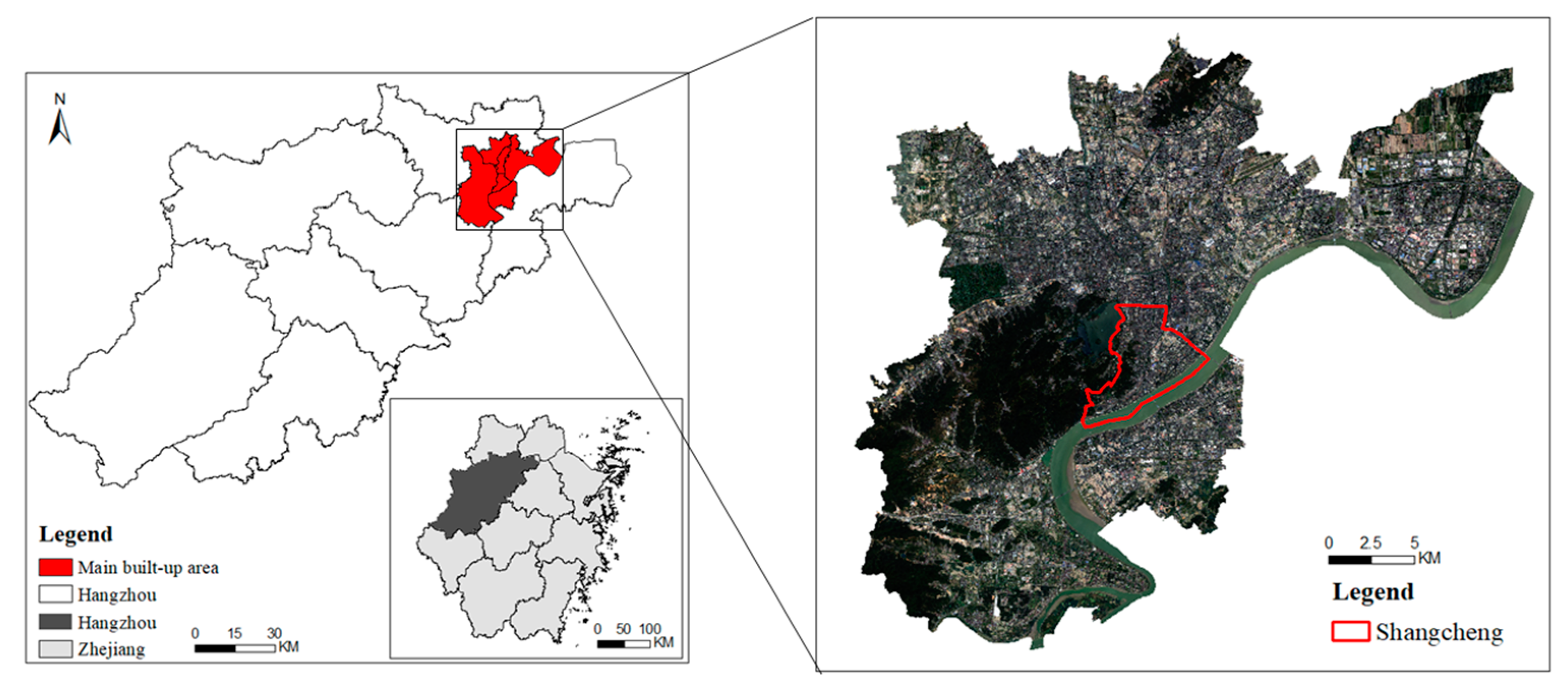


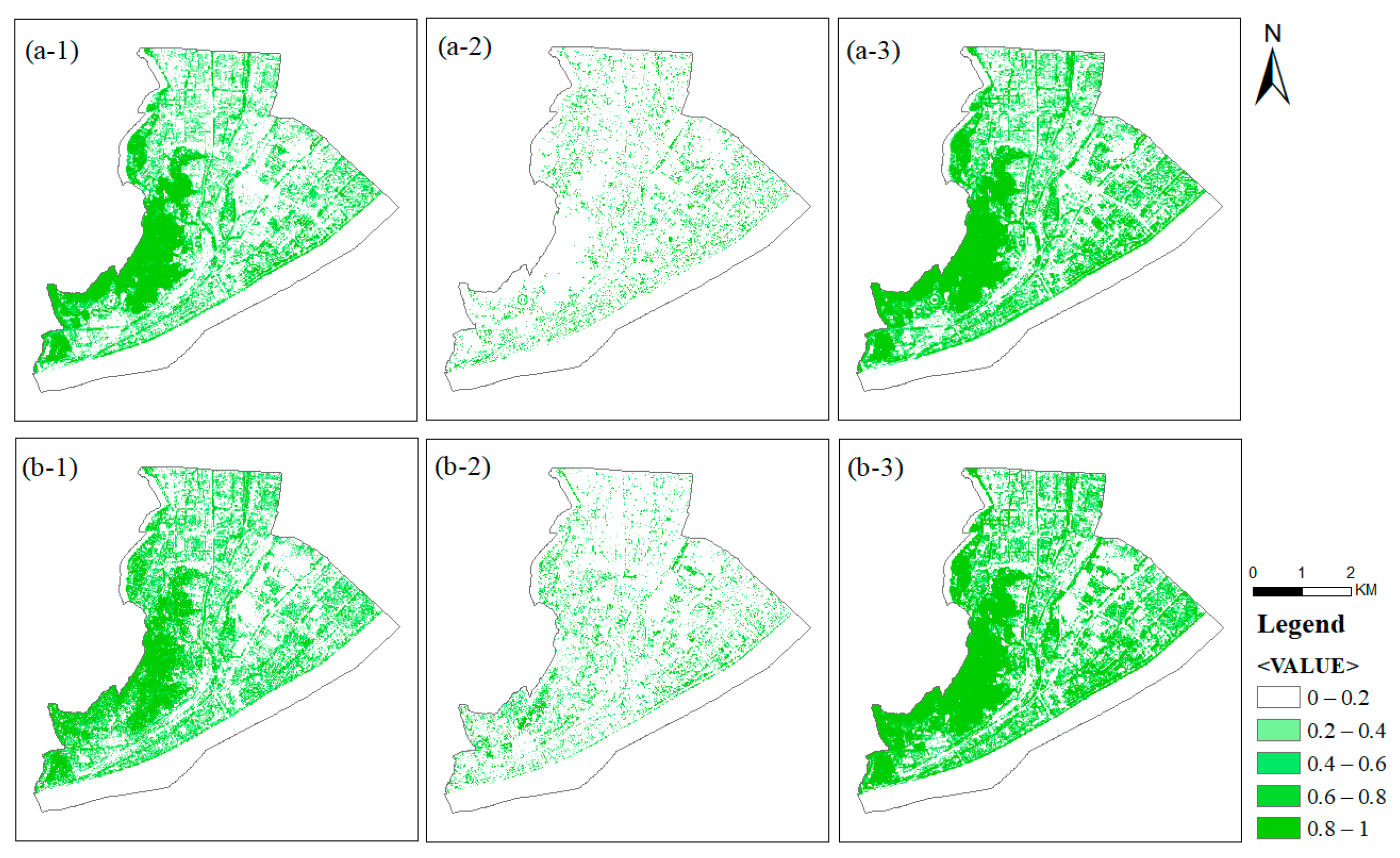
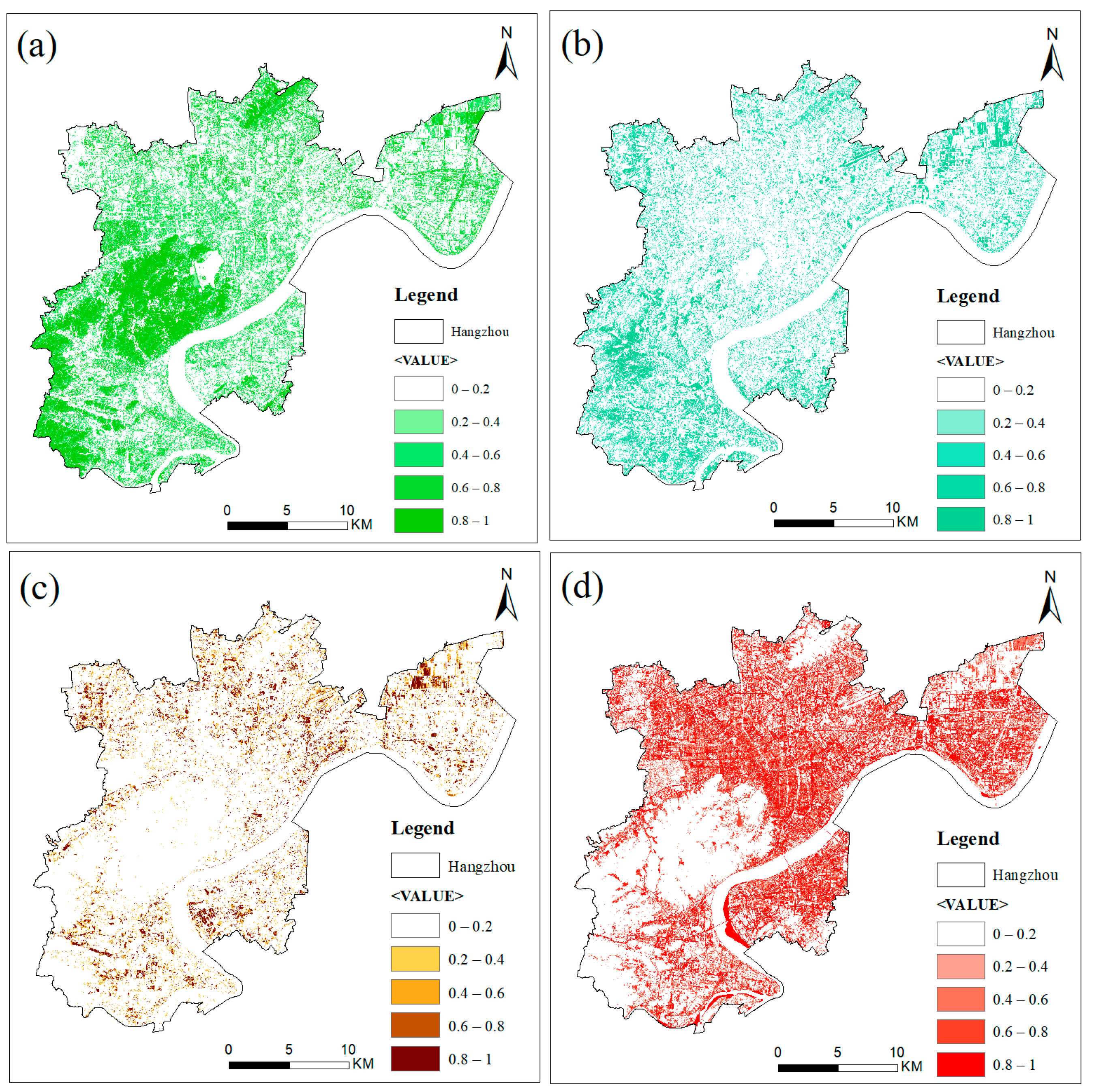
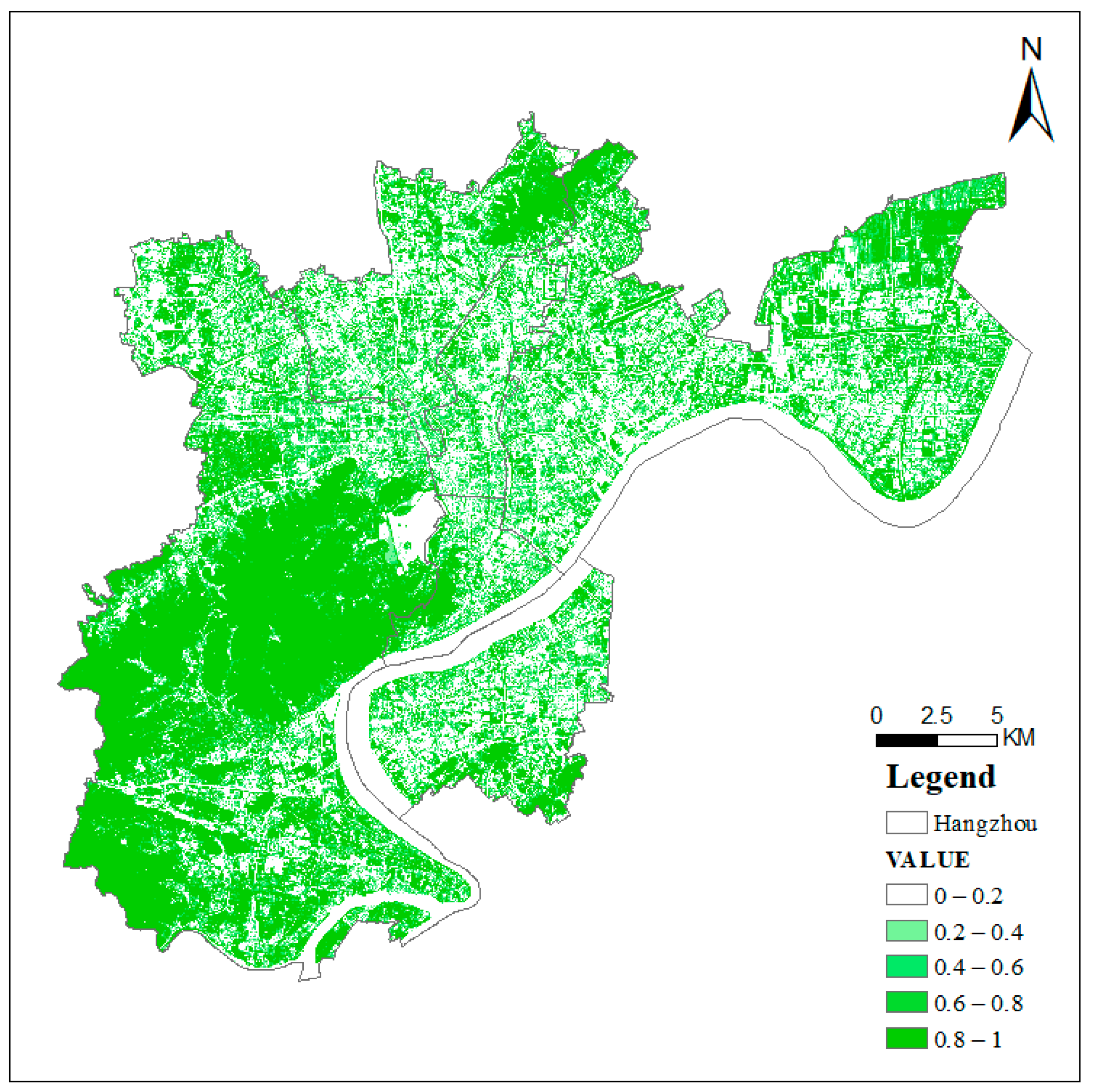


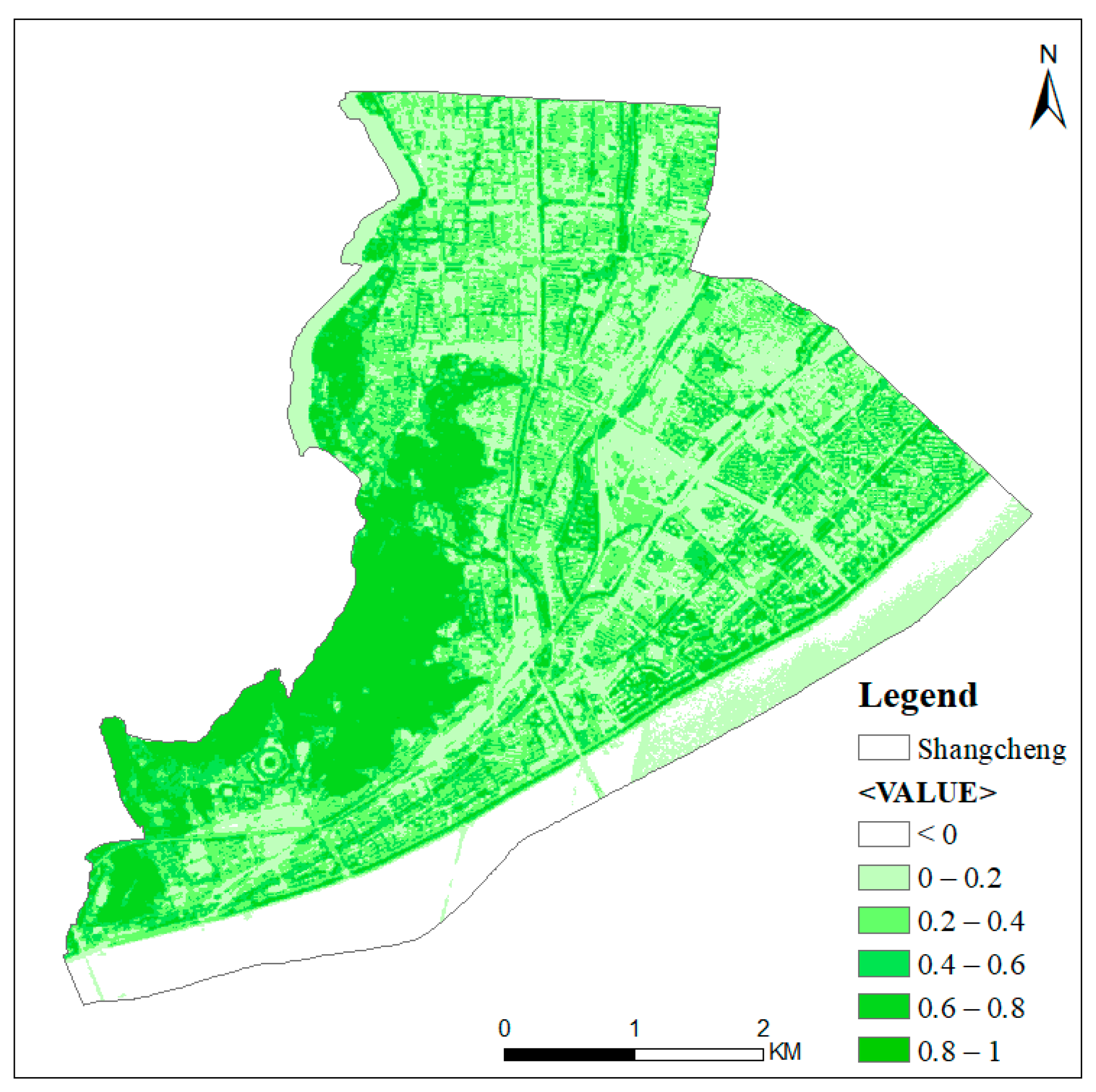
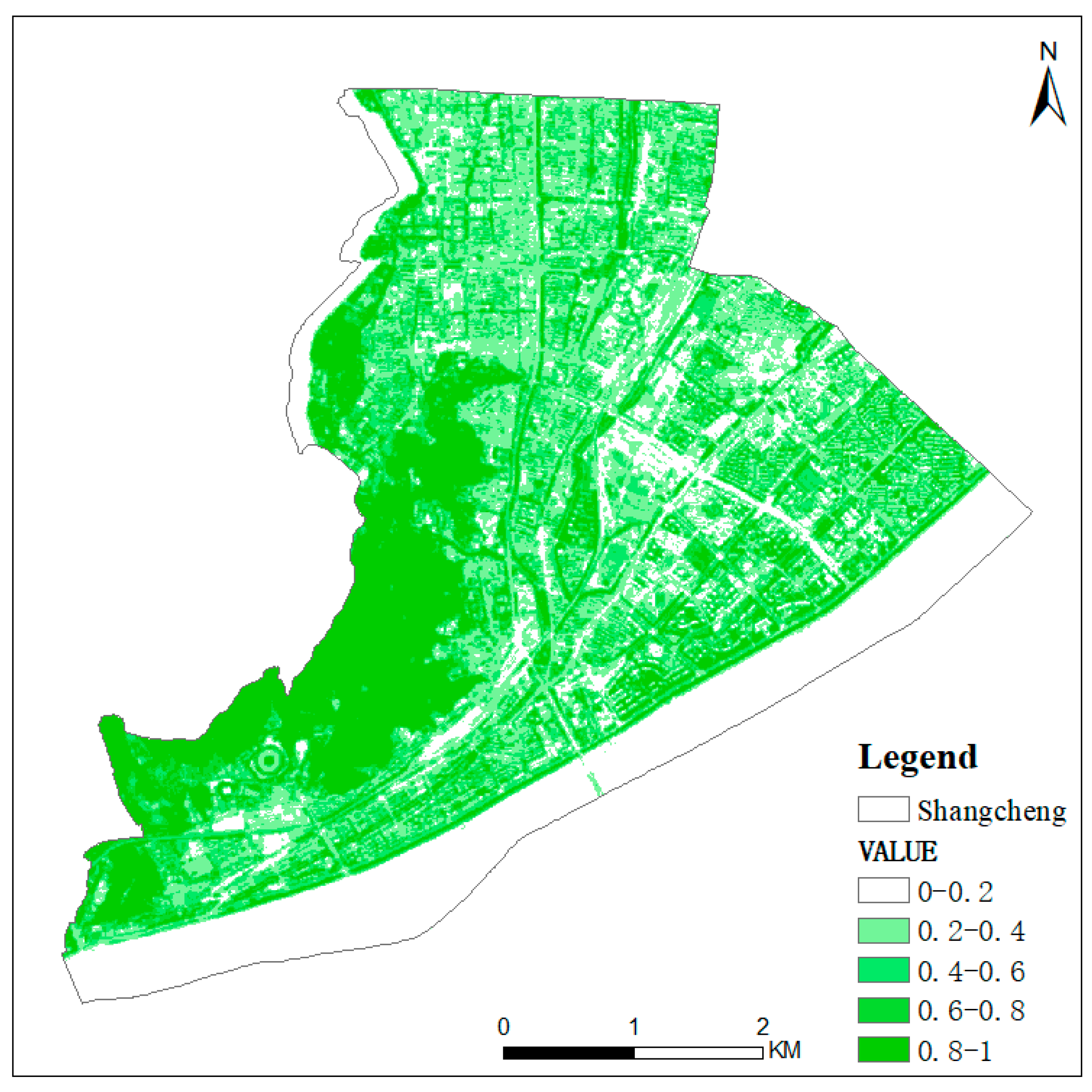
| Sensor | Band Number | Wavelength (μm) | Spatial Resolution (m) | Width (km) | Side Pendulum Angle | Revisit Cycle |
|---|---|---|---|---|---|---|
| PMS | 1 | 0.45–0.90 | 2 | 60 | ±35° | 4 Days |
| 2 | 0.45–0.52 | 8 | ||||
| 3 | 0.52–0.59 | |||||
| 4 | 0.63–0.69 | |||||
| 5 | 0.77–0.89 |
| NO. | Forest Area (km2) | Grassland Area (km2) | UGS Area (km2) | Percentage of UGS (%) |
|---|---|---|---|---|
| 1 | 6.53 | 2.96 | 9.48 | 36.38 |
| 2 | 7.78 | 1.80 | 9.58 | 36.76 |
| 3 | 6.36 | 2.54 | 8.9 | 34.15 |
| 4 | 6.32 | 2.92 | 9.24 | 35.46 |
| 5 | 6.12 | 2.37 | 8.49 | 32.58 |
| 6 | 7.38 | 1.96 | 9.34 | 35.84 |
| Forest | Grassland | UGS | ||||
|---|---|---|---|---|---|---|
| Area (km2) | Percentage (%) | Area (km2) | Percentage (%) | Area (km2) | Percentage (%) | |
| 2018 | 6.52 | 25.02 | 2.96 | 11.36 | 9.48 | 36.38 |
| 2020 | 7.93 | 30.43 | 2.41 | 9.25 | 10.34 | 39.68 |
| Grade | Forest (km2) | Grassland (km2) | UGS (km2) | Percentage of Forest (%) | Percentage of UGS (%) |
|---|---|---|---|---|---|
| Very low (0–0.2) | 7.17 | 7.00 | 14.17 | 1.02 | 2.01 |
| Low (0.2–0.4) | 25.59 | 18.49 | 44.06 | 3.62 | 6.24 |
| Medium (0.4–0.6) | 40.34 | 24.50 | 64.84 | 5.71 | 9.18 |
| Medium high (0.6–0.8) | 45.34 | 25.41 | 70.75 | 6.42 | 10.02 |
| High (0.8–1) | 100.15 | 56.06 | 156.21 | 14.18 | 22.12 |
| Total | 218.59 | 131.46 | 350.05 | 30.95 | 49.56 |
| Grade | Xihu | Xiacheng | Shangcheng | Jianggan | Gongshu | Binjiang | ||||||
|---|---|---|---|---|---|---|---|---|---|---|---|---|
| (km2) | (%) | (km2) | (%) | (km2) | (%) | (km2) | (%) | (km2) | (%) | (km2) | (%) | |
| Very low (0–0.2) | 6.01 | 1.94 | 0.64 | 2.18 | 0.46 | 1.77 | 4.13 | 2.07 | 1.64 | 2.37 | 1.30 | 1.80 |
| Low (0.2–0.4) | 19.65 | 6.35 | 1.96 | 6.68 | 1.57 | 6.02 | 12.03 | 6.02 | 4.84 | 6.99 | 4.01 | 5.55 |
| Medium (0.4–0.6) | 30.21 | 9.76 | 2.56 | 8.73 | 2.27 | 8.71 | 17.33 | 8.67 | 6.78 | 9.79 | 5.68 | 7.86 |
| Medium high (0.6–0.8) | 36.54 | 11.81 | 2.20 | 7.50 | 2.21 | 8.48 | 17.46 | 8.73 | 6.98 | 10.08 | 5.36 | 7.42 |
| High (0.8–1) | 107.05 | 34.60 | 2.14 | 7.30 | 3.83 | 14.70 | 25.23 | 12.62 | 9.91 | 14.31 | 8.11 | 11.23 |
| Total | 199.46 | 64.46 | 9.5 | 32.39 | 10.34 | 39.68 | 76.18 | 38.09 | 30.15 | 43.54 | 24.46 | 33.87 |
Disclaimer/Publisher’s Note: The statements, opinions and data contained in all publications are solely those of the individual author(s) and contributor(s) and not of MDPI and/or the editor(s). MDPI and/or the editor(s) disclaim responsibility for any injury to people or property resulting from any ideas, methods, instructions or products referred to in the content. |
© 2023 by the authors. Licensee MDPI, Basel, Switzerland. This article is an open access article distributed under the terms and conditions of the Creative Commons Attribution (CC BY) license (https://creativecommons.org/licenses/by/4.0/).
Share and Cite
Zhang, D.; Liu, H.; Yu, Z. Analysis on the Rationality of Urban Green Space Distribution in Hangzhou City Based on GF-1 Data. Sustainability 2023, 15, 12027. https://doi.org/10.3390/su151512027
Zhang D, Liu H, Yu Z. Analysis on the Rationality of Urban Green Space Distribution in Hangzhou City Based on GF-1 Data. Sustainability. 2023; 15(15):12027. https://doi.org/10.3390/su151512027
Chicago/Turabian StyleZhang, Danying, Haijian Liu, and Zhifeng Yu. 2023. "Analysis on the Rationality of Urban Green Space Distribution in Hangzhou City Based on GF-1 Data" Sustainability 15, no. 15: 12027. https://doi.org/10.3390/su151512027
APA StyleZhang, D., Liu, H., & Yu, Z. (2023). Analysis on the Rationality of Urban Green Space Distribution in Hangzhou City Based on GF-1 Data. Sustainability, 15(15), 12027. https://doi.org/10.3390/su151512027







